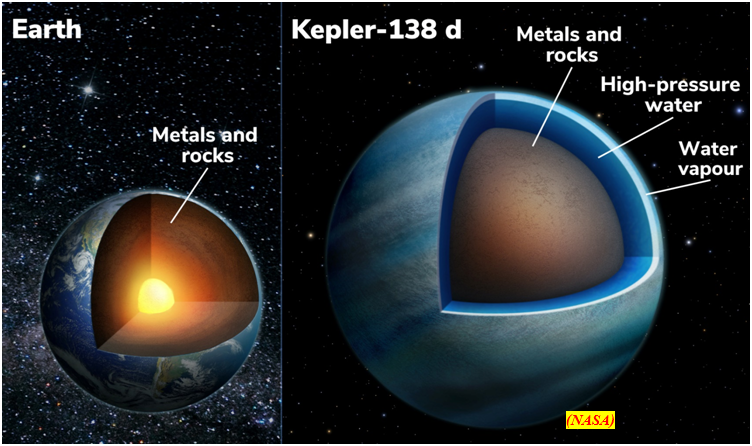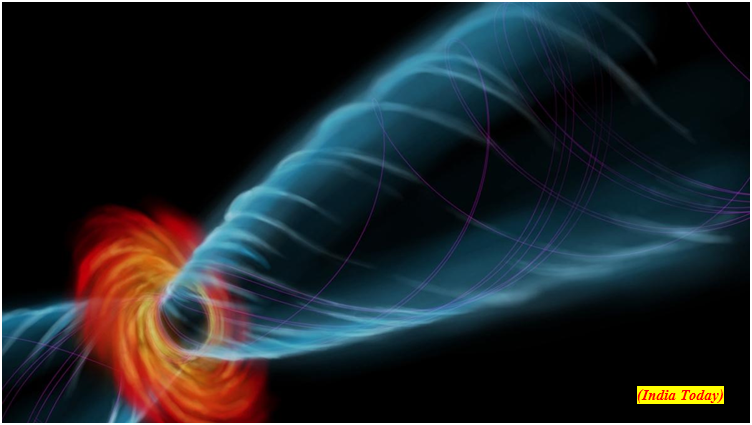Newly discovered twin Kepler planets could be unique water worlds (GS Paper 3, Science and Tech)

Why in news?
- Astronomers have discovered that two exoplanets orbiting a red dwarf star that are unique in their composition.
- These two exoplanets are unlike any other discovered outside the Solar System. These two planets are filled with water.
Details:
- These exoplanets located in a planetary system 218 light-years away in the constellation Lyra are unique since the liquid makes up a large volume of their composition.
- Astronomers observed exoplanets Kepler-138c and Kepler-138d with Hubble and the retired Spitzer space telescopes to make the watery discovery.
How they were discovered?
- The planets, which are about one and a half times the size of the Earth, were discovered along with its host star by NASA’s Kepler Space Telescope.
- While the water wasn't detected directly, researchers, by comparing the sizes and masses of the planets to models, conclude that a significant fraction of their volume should be made of materials that are lighter than rock but heavier than hydrogen or helium.
- The most common of these candidate material is water.
Density:
- The researchers maintained that with volumes more than three times that of Earth and masses twice as big, planets c and d have much lower densities than Earth.
- This is surprising because most of the planets just slightly bigger than Earth that has been studied in detail so far all seemed to be rocky worlds like ours.
TOI-1452 b:
- Recently, another team at the University of Montreal found another planet, called TOI-1452 b, that could potentially be covered with a liquid-water ocean.
Fossil lizards and snakes indicate climate of Late Miocene hominid locality of Haritalyangar, Himachal Pradesh
(GS Paper 3, Environment)
Why in news?
- Remains of fossil lizards and snakes have been discovered recently from a late Miocene hominid locality of India (dated 9.1 Million Years) in Haritalyangar, Himachal Pradesh.
- It indicates a seasonally wet sub-humid to semi-arid climate in the area with mean annual temperature of around 15–18.6°C during that period.
- It was similar to condition in the area today.

Squamates:
- Lizards and snakes are cold-blooded squamates whose distribution, richness, and diversity of are highly dependent on temperature and climatic conditions.
- For this reason, squamates are widely regarded as excellent indicators of past climates, particularly ambient temperatures.
Taxa Varanus:
- Wadia Institute of Himalayan Geology (WIHG), Dehradun in collaboration with other institutes, documented the taxa; Varanus, Python, a colubrid and a natricid from this region for the first time.
- The occurrence of taxa Varanus in Haritalyangar is important in regard to its past biodiversity because varanids have a limited fossil record in Asia.
- Also, the fossil Python from South Asia remains poor except for the earliest record from Pakistan (dated ca. 18 Ma) and Kutch, Gujarat (dated ca. 14-10 Ma).
- A co-existence of Varanus and Python, two iconic squamates, revealed a wider distribution of the clade in this southern Asian territory.
Key Findings:
- The overall Haritalyangar squamate fauna, which is dominated by both large and small semi-aquatic and terrestrial taxa, indicates a seasonally wet sub-humid to semi-arid climate in the area during the Late Miocene, 9.1 Ma.
- Moreover, the mean annual temperature must have been high in the region at that time (not less than 15–18.6°C, similar to the mean annual temperature in this area today), indicated by the occurrence of important thermophilic elements such as Varanus and Python.
Indian telescope reveals the secret of mysterious circles in space
(GS Paper 3, Science and Tech)
Why in news?
- Recently, an international team of researchers, including from India, has revealed that mysterious hazy circles of radio emission deep in celestial space could be remnants of supernovas, the biggest explosions in the universe.
- The emission circles known as Odd Radio Circles (ORCs) were detected recently using some of the most sensitive international radio telescopes.
Details:
- Astronomers used the Square Kilometer Array (SKA) in Australia & South Africa, the Giant Metrewave Radio Telescope (GMRT) in India, and the Low-Frequency Array (LOFAR) in the Netherlands to identify these radio emission circles, which are not seen in any other form of radiation.
- Researchers believe that some of these objects could be 1 million light-years across, about 10 times larger than our Milky Way, and are considered mysterious, as these objects could not be explained by any previously known astrophysical phenomena.

Contribution by Indian side:
- The discovery was led by Dr. Amitesh Omar, a Scientist at Aryabhatta Research Institute of observational sciences (ARIES), Nainital.
- His research indicates that these could be remnants of thermonuclear supernovas triggered by the explosion of a white dwarf star in a binary system heavier than 1.4 times the mass of the Sun.
- He invoked a widely known mechanism of disruption of a star by extreme tidal forces exerted by a massive black hole as the star comes in close proximity to the central massive black hole in a galaxy.
- In this process, the star is destroyed, and about half its mass is thrown away from the black hole at very high speeds. This disruption process releases a huge amount of energy, similar to that produced in a supernova explosion.
- The sudden release of huge energy creates shocks, which can traverse to around a million light-years in intergalactic space.
Conclusion:
- Researchers maintain that these radio circles are associated with distant galaxies as their centers have a known optical galaxy, therefore cannot be considered intergalactic supernovae.




